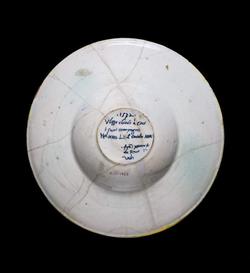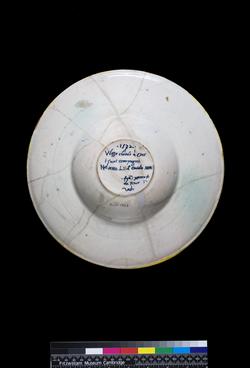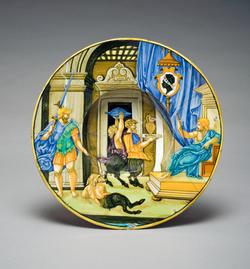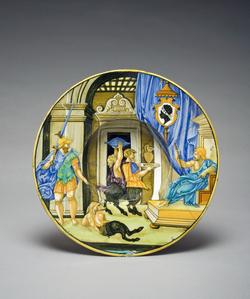Current Location: Gallery 7 (Courtauld)
Titles
Ulysses commanding Circe to restore his Companions to their Rightful Forms
Maker(s)
Painter:
Avelli, Francesco Xanto
Printmaker:
Raimondi, Marcantonio
(After)
Printmaker:
Monogrammist I. B.
(After)
Printmaker:
Dente, Marco (Marco da Ravenna)
(After)
Entities
Categories
Description
Maiolica bowl with broad rim, painted in polychrome with Ulysses commanding Circe to restore his Companions to their Rightful Forms.
Buff earthenware, tin-glazed overall; the reverse pale beige and tinged with green. Painted in blue, turquoise-green, yellowish-green, yellow, orange, beige, brown, manganese, black, and white. Shape 58. Circular with a wide, slightly sloping rim and small, deep well.
Ulysses commanding Circe to restore his Companions to their Rightful Forms. Ulysses stands on the left, his head turned towards Circe, and his left arm pointing to one of his companions with a swine's hind limbs and head, who reclines in the foreground. In the middle, two of his men with swine's hind legs bear vessels to Circe; the one on the left has a covered dish and the other a ewer and basin. Behind them is a doorway with the date `1532' inscribed in a panel above it. On the right, Circe sits on a throne, holding a sceptre or wand in her right hand. Above her, imposed on a draped curtain is a shield charged with the arms of Pucci of Florence: argent, a moor's head proper wearing a headband argent charged with three hammers sable, with behind, a papal ombrellino. The edge is yellow. The back is inscribed in the middle in dark blue: `.1532./Vlisse chiede a Circe/i suoi compagni/Nel .XIIII. Li d Ouidio Met:/.fra: Xanto.A./da Rovi...i / Urbi . . .' (Ulysses asks Circe for his companions In the 14th Book of Ovid's Metamorphoses:.francesco Xanto.Avelli of Rovigo in Urbino).
Notes
History note: Conte Ferdinando Pasolini Dall'Onda, Faenza; Paris, Ridel, 14 December 1853, Catalogue d'une belle collection de majoliques italiennes des diverses fabriques des XVe, XVIe & XVIIe siècles, lot 171; Andrew Fountaine IV (1808-73); his heir; Christie's, 16 June 1884, Catalogue of the celebrated Fountaine collection of majolika, Henry II ware, Palissy ware, Nevers ware, Limoges enamels . . ., removed from Narford Hall, Norfolk, lot 39; Lowengard; Bourgeois Frères; Cologne, Heberle, 19-27 October 1904, Collection Bourgeois Frères, Catalogue des objets d'art et e haute curiosité composant la collection Bourgeois Frères et dont la vente aura lieu à Cologne dans la grande salle du casino (Augustinerplatz 7) du mercredi 19 au jerdi 27 octobre 1904, lot 93; Dr Alfred Pringsheim; Sotheby's, 20 July 1939, Catalogue of the renowned collection of Italian majolica, the property of Dr Alfred Pringsheim of Munich, lot 390; Marmaduke Langdale Horn (1890-1953).
Legal notes
M.L. Horn Bequest
Measurements and weight
Diameter: 26 cm
Height: 4.6 cm
Acquisition and important dates
Method of acquisition: Bequeathed
(1953-10-22)
by
Horn, Marmaduke Langdale
Dating
16th Century, second quarter
Renaissance
Production date:
dated
AD 1532
Note
Francesco Xanto was a freelance maiolica painter and it is not known in which workshop this dish was made. Xanto frequently constructed the scenes on his dishes with figures taken from several different engraved sources. The scene from the story of Ulysses and Circe was constructed from four. Ulysses was derived from 'Jupiter', dated 1528, by the Monogrammist IB. The figure also resembles Perseus in the woodcut illustration of Perseus and Andromeda in 'Ouidio methamorphoseos vulgare', Venice (Lucantonio Giunta), 1497. Circe was taken from the Muse Euterpe in the engraving by Marcantonio Raimondi of Raphael's 'Parnassus'. The two servants were adapted and transposed from the servants at the banquet given in Aeneas' honour by Dido, in the lowest right panel of the 'Quos Ego' engraved by Marcantonio Raimondi. The man with a swine's head in the foreground was probably derived from a figure in the 'Battle of the Romans and Carthaginians' engraved by Marco Dente after Raphael or Giulio Romano.
This plate belongs to a service made for a member of the Pucci family of Florence, which comprises a salt, thirty-four dishes dated 1532, and two dishes dated 1533. The plate is decorated with the story of Ulysses and Circe which is told in Ovid's Metamorphoses, Book XIV, 248-307, the incident portrayed on the dish in lines 293-8. Circe had transformed Ulysses' companions into swine after giving them poisoned wine at a feast in her palace. Only one, Eurylochus, refrained from drinking and escaped to tell Ulysses. When the latter arrived at the palace he refused the poisoned cup offered by Circe and threatened her with his sword. Then, having made a marriage pact with her, he demanded as a wedding gift that she return his companions to their rightful forms. This subject also occurs on a dish of 1533 in the Louvre, which has the same figures of Ulysses and Circe, but is otherwise rendered differently.
School or Style
Renaissance
People, subjects and objects depicted
Components of the work
Decoration
composed of
high-temperature colours
( blue, turquoise-green, yellowish-green, yellow, orange, beige, brown, manganese, black, and white)
Materials used in production
Tin-glaze
Earthenware
Techniques used in production
Moulding
: Buff earthenware, tin-glazed overall; the reverse pale beige and tinged with green. Painted in blue, turquoise-green, yellowish-green, yellow, orange, beige, brown, manganese, black, and white.
Tin-glazing
Inscription or legends present
- Text: 'af' and '83'
- Location: On the back
- Method of creation: Incised
- Type: Mark
- Text: 1532./Vlisse chiede a Circe/i suoi compagni/Nel .XIIII. Li d Ouidio Met:/.fra: Xanto.A./da Rovi...i / Urbi . . .'
- Location: In the middle of the back
- Method of creation: Painted in
- Type: Inscription
References and bibliographic entries
-
Del Museo Pasolini in Faenza, Descrizione
page(s): p. 14
-
Catalogue d'une belle collection de majoliques italiennes des diverses fabriques des XVe, XVIe & XVIIe siècles
-
Catalogue of the celebrated Fountaine collection of majolika, Henry II ware, Palissy ware, Nevers ware, Limoges enamels, carvings in ivory, hone stone and rock crystal, Greek and Roman coins, ancient armour &c. &c., removed from Narford Hall, Norfolk
-
Collection Bourgeois Frères, Catalogue des objets d'art et e haute curiosité composant la collection Bourgeois Frères et dont la vente aura lieu à Cologne dans la grande salle du casino (Augustinerplatz 7) du mercredi 19 au jerdi 27 octobre 1904
-
Die Majolikasammlung Alfred Pringsheim in München, II
-
Rimpianto (Due collezioni faentine disperse)
page(s): pp. 105-19
-
Corpus della maiolica italiana, II, Le maioliche datate dal l53l al l535
page(s): p. 21
-
Catalogue of the renowned collection of Italian majolica, the property of Dr Alfred Pringsheim of Munich
-
The Fountaine collection of maiolica
page(s): p. 444
-
Francesco Xanto Avelli's Pucci Service (1532-1533): Part Two
page(s): 26-9
-
Francesco Xanto's Pucci Service (1532-1533): Part One
page(s): 32-43
-
Xanto and Ariosto
page(s): p. 254
-
Italian Maiolica and Incised Slipware in the Fitzwilliam Museum Cambridge
page(s): pp. 338-340
-
Catalogo completo dell'opera grafica di Georg Pencz
page(s): 10-18
-
The Art of the Italian Potter, Maiolica and Porcelain from a Private Collection
-
Maiolica: Italian Renaissance Ceramics in the Metropolitan Museum of Art
page(s): 182-3
-
Ceramics. 400 Years of British Collecting in 100 Masterpieces
page(s): 188-9
-
The Golden Age of Maiolica-Painting. Catalogue of a Private Collection
page(s): 242-5
-
Ancora sul ruolo di Raffaello nell'opera di Xanto Avelli
page(s): 21-35
Related exhibitions
Identification numbers
Accession number: C.11-1953
Primary reference Number: 71355
Stable URI
Audit data
Created: Saturday 6 August 2011
Updated: Tuesday 12 August 2025
Last processed: Tuesday 12 August 2025
Associated departments & institutions
Owner or interested party:
The Fitzwilliam Museum
Associated department:
Applied Arts
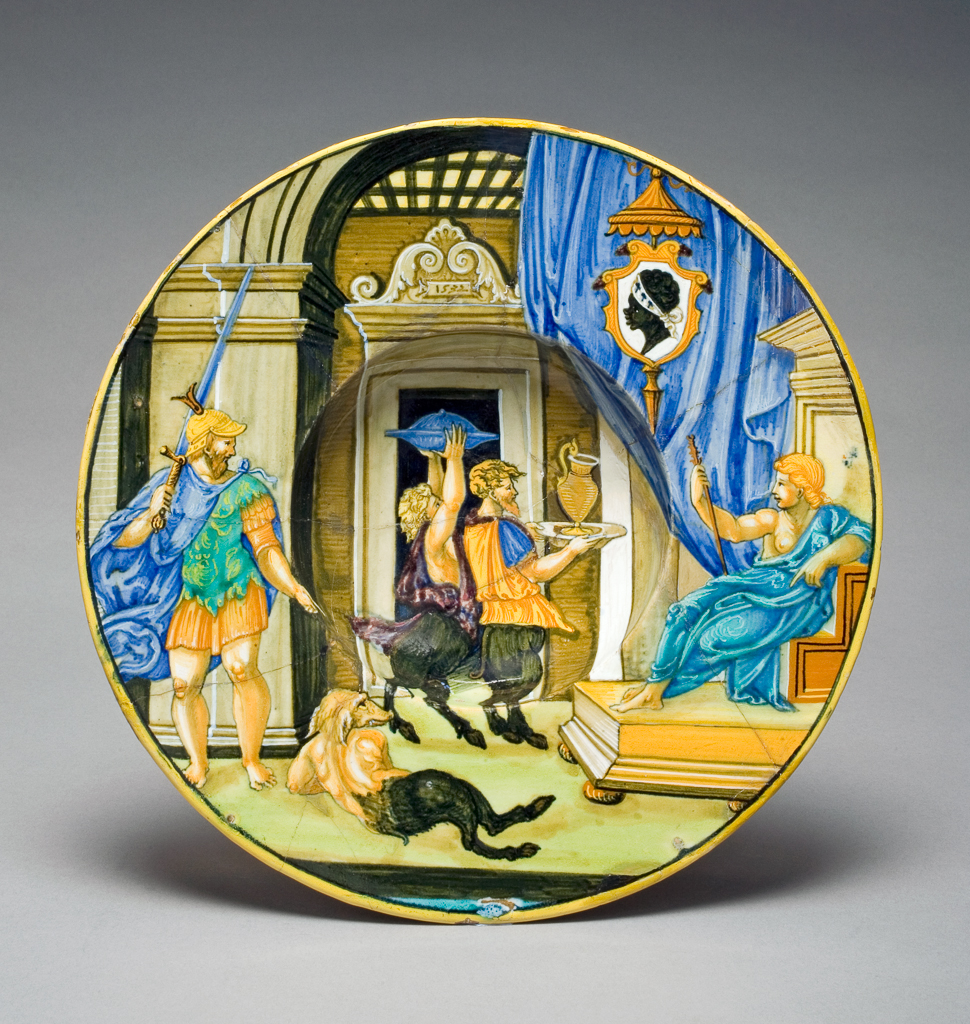
 IIIF Manifest
IIIF Manifest
